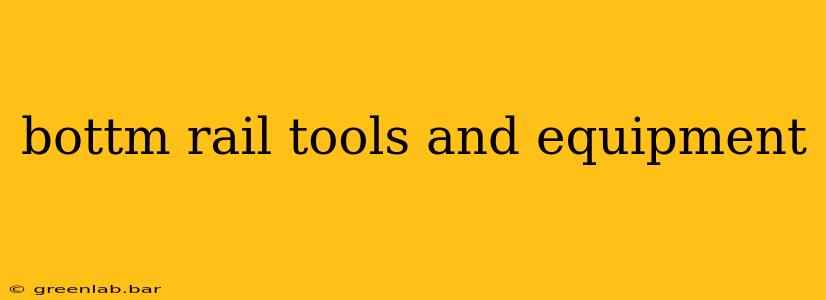Installing and working with bottom rails requires the right tools and equipment to ensure a safe, efficient, and high-quality job. Whether you're a professional fence installer, a DIY enthusiast tackling a home project, or a construction worker on a larger-scale undertaking, understanding the necessary tools is crucial. This guide provides a comprehensive overview of the essential tools and equipment needed for bottom rail installation and related tasks.
Essential Tools for Bottom Rail Installation
The specific tools required might vary depending on the material of your bottom rail (wood, metal, vinyl, etc.) and the complexity of the project. However, some tools are consistently essential:
1. Measuring and Marking Tools:
- Tape Measure: Accurate measurements are fundamental. Choose a durable tape measure with a locking mechanism for ease of use.
- Marking Pencil or Chalk: Clearly mark cutting lines and locations for posts and fasteners. A carpenter's pencil is ideal for wood, while chalk is useful on various surfaces.
- Level: Ensuring your bottom rail is level is crucial for stability and aesthetics. A long level provides better accuracy for longer runs.
2. Cutting Tools:
The choice of cutting tools depends on the rail material:
- For Wood:
- Circular Saw: Offers speed and precision for cutting long lengths of wood.
- Hand Saw: Useful for more intricate cuts or in tighter spaces where a circular saw might be difficult to maneuver.
- Miter Saw: Provides accurate angled cuts for joining rails at corners.
- For Metal:
- Angle Grinder with Cutting Disc: Efficient for cutting metal rails, ensuring clean cuts. Safety glasses and appropriate respiratory protection are mandatory.
- Metal Saw (hacksaw): Useful for smaller cuts and when an angle grinder is impractical.
- For Vinyl:
- Hand Saw with Fine Teeth: A sharp hand saw with fine teeth minimizes chipping and cracking.
- Vinyl Cutter: (specialized tool) if you're working with pre-fabricated vinyl sections.
3. Fastening Tools:
- Drill: Essential for pre-drilling holes before driving screws or bolts to prevent splitting.
- Screwdriver(s): Choose appropriate screwdrivers matching your fasteners (Phillips head, flathead, etc.). A cordless drill with interchangeable bits is highly efficient.
- Hammer: Used for driving nails or other fasteners depending on your chosen materials.
- Post Hole Digger or Auger: If installing posts, a post hole digger or auger is crucial for creating accurate holes.
4. Other Useful Tools:
- Safety Glasses: Protect your eyes from flying debris.
- Work Gloves: Protect your hands from splinters, cuts, and abrasions.
- Clamps: Useful for holding pieces together securely during installation, especially for longer rails.
- Speed Square: Ensures accurate 90-degree angles when cutting and joining rail sections.
Choosing the Right Equipment Based on Material
The material of your bottom rail significantly influences the tools you'll need.
Wood Bottom Rails:
Wood requires tools for precise cutting, drilling, and fastening. Consider using treated lumber for outdoor applications to increase durability and resistance to rot and insect damage.
Metal Bottom Rails:
Metal requires tools capable of cutting and fastening metal. Always prioritize safety when working with metal cutting tools.
Vinyl Bottom Rails:
Vinyl is more delicate and requires tools that avoid excessive force to prevent cracking or damage. Proper preparation and careful cuts are crucial for maintaining the integrity of the vinyl.
Safety Precautions
Always prioritize safety when working with tools and equipment. Wear appropriate safety gear, such as safety glasses, work gloves, and hearing protection when necessary. Follow the manufacturer's instructions for all tools and equipment. If you are unsure about any aspect of the installation process, consult a professional.
This comprehensive guide provides a strong foundation for understanding the tools and equipment needed for bottom rail installation. Remember to always prioritize safety and select tools appropriate for your specific project and material. By utilizing the correct tools and equipment, you can ensure a successful and safe installation process.

